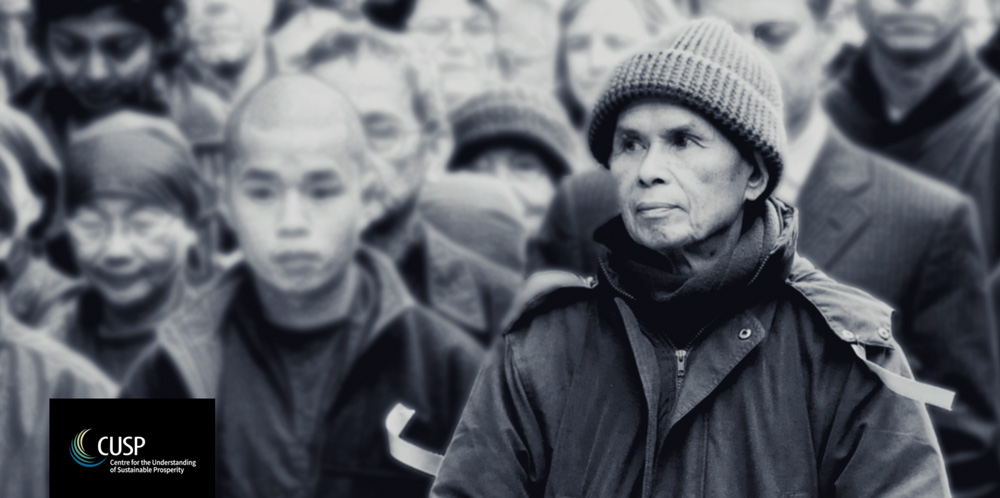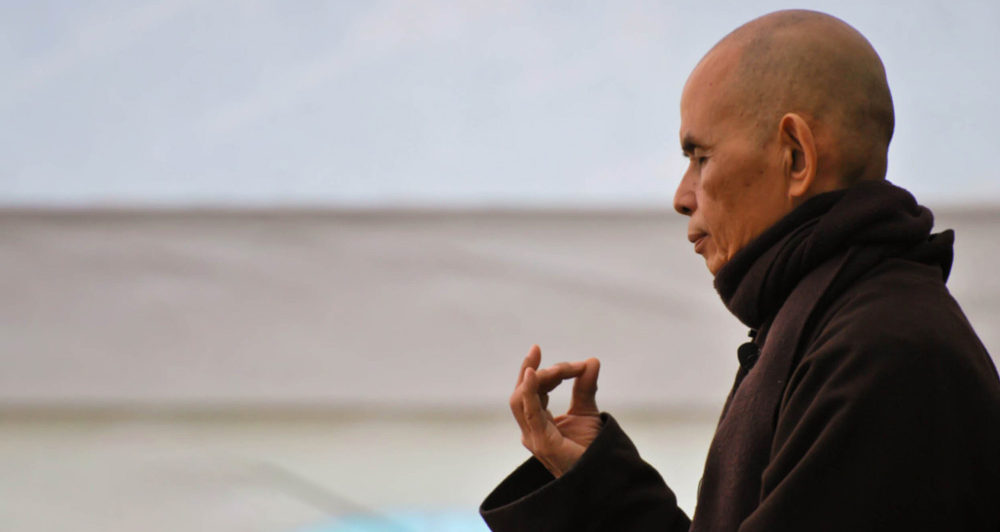CUSP Director Tim Jackson reflects on the life of and work of the late Thich Nhat Hanh and its relevance for contemporary debates about the meaning of prosperity and power. (This blog first appeared on the CUSP website.)

Thich Nhat Hanh, NYC Peace Walk 2009. Image: courtesy of manhhai / flickr.com (CC-BY-NC 2.0)
The Vietnamese Buddhist monk, writer and peace activist Thich Nhat Hanh, who died recently aged 95, left Vietnam for the United States in May 1966 to give an invited seminar at Cornell University in the US. Though he didn’t know it at the time, he would not to see his native land again for almost four decades.
A few days after the New York seminar, on 1 June 1966, Thich Nhat Hanh presented a peace proposal at a conference in Washington, urging the US to stop bombing Vietnam and begin the difficult and painstaking work of reconstruction and reconciliation. On the same day, the South Vietnamese government declared him a traitor, effectively placing him in exile, thousands of miles from home. Shortly afterwards, he was also forced to leave the US under threat of imprisonment. Neither government was keen to hear his anti-war message. But it received a warm reception from those in America uncomfortable with their country’s involvement in the conflict. In January 1967, the civil rights activist Martin Luther King Jr nominated him for the Nobel Peace Prize. ‘Here is an apostle of peace and nonviolence,’ he wrote in his nomination letter, ‘separated from his own people while they are oppressed by a vicious war which has grown to threaten the sanity and security of the entire world.’ The two men campaigned for peace together at a conference in Geneva in June of the same year. Thich Nhat Hanh went on to lead the Vietnamese Buddhist Peace Delegation at the Paris Peace Talks.
By that time, King was dead: a victim of the assassin’s bullet. Thich Nhat Hanh was devastated. ‘I could not eat. I could not sleep,’ he said. ‘I made a deep vow to continue building what he called “the beloved community”, not only for myself but for him also.’ During a peace demonstration in Philadelphia, he was asked by a US reporter whether he was from the north or south of Vietnam. ‘If I said I was from the north, he would think I was anti-American,’ he wrote years later. ‘If I said I am from the south, he would think I was … pro-American. So I smiled and said: “I am from the center.”’
This was in part of course a rejection of the division that haunted his country. An expression of solidarity with all those suffering in the conflict. And a refusal to succumb to the dystopian vision of power that leads inevitably to the desecration of life. But it was also true in a literal sense. Born in 1926 in the city of Hué in central Vietnam, Thich Nhat Hanh was just 7 years old when he came across a drawing of the Buddha, sitting cross-legged on the grass, radiating serenity and peace. The image was in such stark contrast to the conflict and suffering the boy saw around him, it was to set the course of his entire life. At 16 years old, he enrolled at the Tu Hieu monastery in Hué city as a novice monk in the Vietnamese Zen tradition of Buddhism.

Thich Nhat Hanh with Dr. Martin Luther King, Jr at a joint press conference on 31 May 1966, Chicago Sheraton Hotel. © Plum Village Community of Engaged Buddhism (PVCEB).
By the time he’d completed his studies, Vietnam was on the brink of all-out war. The former French colony was slipping away from western influence, to the dismay of the US and its allies. When the French finally withdrew from the region in 1954, the country was split in two along the 17th parallel, just north of Hué, setting the scene for twenty years of tragic American involvement in an ultimately disastrous military engagement. Officially, it was a civil war between the newly formed countries of North and South Vietnam. But many people understood it for what it was: a brutal tussle for power in the Cold War being played out between the US and the Soviet Union. As the conflict escalated in the 1960s, first John F. Kennedy and then Lyndon B. Johnson committed ever-greater resources to the battlefield, to the rising dismay of many Americans.
As a young monk in Hué, Thich Nhat Hanh learned that non-attachment is the path to enlightenment. But from early on he was uncomfortable with the conservatism inherent in traditional Buddhist teaching. The boy who’d been inspired by the serenity in the Buddha didn’t just covet peace for himself. He demanded from it a response to the suffering he saw around him. In the 1950s, having completed his training, he began to play an active role in the movement to modernize Buddhism and to make it more relevant to the lives and the hardships of ordinary people.
The premise was clear. If the peace sought in monastic retreat was not simply to be a gratuitous pleasure, it must be brought back into the world somehow. It must translate into action. It must stand firm against the suffering of others. The young activists who gathered around Thich Nhat Hanh came to believe that nonviolent protest—and what he called ‘compassionate action’—was a necessary response to the injustice of war. ‘When bombs begin to fall on people,’ he said, ‘you cannot stay in the meditation hall.’ From the soil of suffering grows the lotus of compassion.
Some demonstrations of that principle were dramatic. In the early 1960s, several monks set themselves on fire to protest against the atrocities and injustices of war. Trying to explain these horrendous ‘self-immolations’ to Westerners at the time, Thich Nhat Hanh described them as acts of love not desperation. But to offer young people in Vietnam a less drastic means of protest, he established the School of Youth for Social Service, which trained thousands of young volunteers, both monastic and lay, to relocate refugees and help them rebuild their lives.
Its services were very soon called into action. In 1964, at the height of the conflict, the country was hit by one of the worst floods in living memory. Heavy rains began to fall on central Vietnam during the afternoon of 7 November and continued for six whole days. Homes, and sometimes whole villages, were swept away in the flooding. More than six thousand people lost their lives. The entire country was mobilized in the relief effort. But no one was particularly keen to risk getting caught in the violence still plaguing those regions worst hit by floods.
This was the moment when Thich Nhat Hanh took a small team of his volunteers along the Thu Bon River in seven rowing boats piled high with food and medical provisions. Sometimes trapped in crossfire, sometimes succumbing to sickness themselves, the volunteers made their way high into the mountains, bringing aid to anyone who needed it, whichever side of the conflict they were on. This sense of unqualified compassion for all living beings was a fundamental precept in what Thich Nhat Hanh was later to call Engaged Buddhism.

Thich Nhat Hanh. Photograph: © Plum Village Community of Engaged Buddhism
During his thirty nine years in exile, he was to become renowned for bringing Buddhist ideas and concepts to a western audience. Though it was intended as a guide for social workers in Vietnam, his book on The Miracle of Mindfulness (1975), rapidly became a bestseller and ended up being published in 30 languages worldwide. Its defining success was to take mindfulness out of the meditation hall and demonstrate its usefulness in everyday life. he published over a 100 works in English, writing on subjects as varied as happiness, mindfulness, peace, suffering, grief and power.
In The Art of Power (2008) Thich Nhat Hanh argues that what we think of as power in western society is really a form of craving: for wealth, property, possessions, status, comfort, sex. And for dominance over others in pursuit of these things. To be ruled by our cravings is to intensify our suffering. Not only for those excluded from power but even for those who use economic or military power to satisfy them. Suffering can only be alleviated, he insisted, by freeing ourselves from craving. He went on to offer a precise set of instructions on how this seemingly impossible feat might be achieved. Engaged Buddhism is less a religion than a playbook of practical suggestions on how to live, work, love and even breathe in ways that free us from craving. Power lies not, as capitalism insists, in the endless stimulation of desires achieved only through dominion over others. It lies in our ability not to be ruled by our cravings.
The legacy of Thich Nhat Hanh’ life extends far beyond his role in bringing the Vietnam war to a close. Shortly after finding himself exiled from his home country he was also forced to leave the US for fear of imprisonment. He eventually settled in France where he founded the pioneering community Plum Village, building it up from a small farmstead to a thriving ecological retreat which—outside of the pandemic—would host more than 8000 international visitors a year—and soon became the epicentre of a worldwide community of followers of Thich Nhat Hanh’s work. His own life was a living example of the ideas he wrote and spoke about.
Reflecting on the experience of suddenly finding himself homeless and stateless at the age of 39, Thich Nhat Hanh recalled waking up in the middle of the night with a sense of panic, not knowing where he was. A recurring dream would often find him back in the temple in Hué, where he first trained as a novice monk. ‘I would be climbing a green hill covered with beautiful trees when, halfway to the top, I would wake up and realize that I was in exile,’ he recounted. ‘I had to breathe in and out and remember what city and country I was in’. When a severe stroke left him partly paralysed and barely able to speak at the age of 88, it was to the Hué monastery that he returned to spend his remaining days. It was there that he died at 00.00 on 22nd January 2022, surrounded by some of his many followers.
Exile had left the younger Thich Nhat Hanh desperate to find a way to get home. But it also led him towards a profound understanding. ‘Our true home is the present moment,’ he said. ‘Whatever is happening right here, right now,’ that is our home. This isn’t just an abstract idea, he insisted, but ‘a solid reality’ that we can learn to experience for ourselves. To set ourselves on the path of reaching this experience is the greatest power that we have. At the end of the day, he said, there is no way home. ‘Home is the way’.
. . .
Parts of this blog are adapted from Chapter 9 in Post Growth—life after capitalism.
